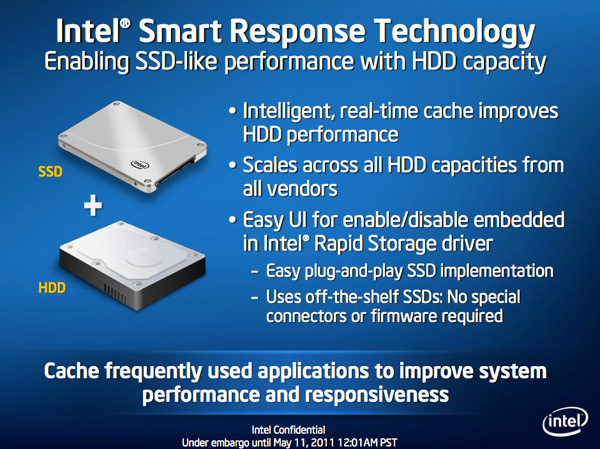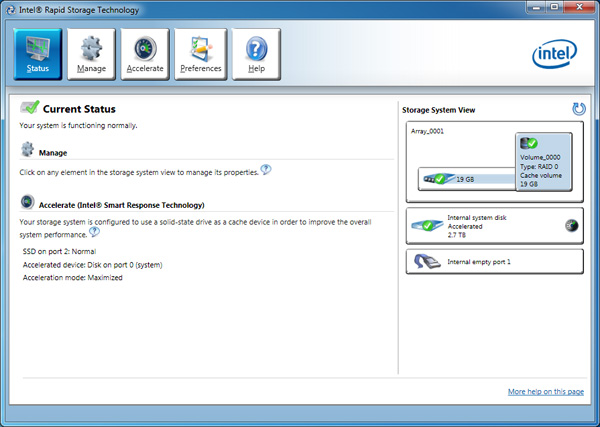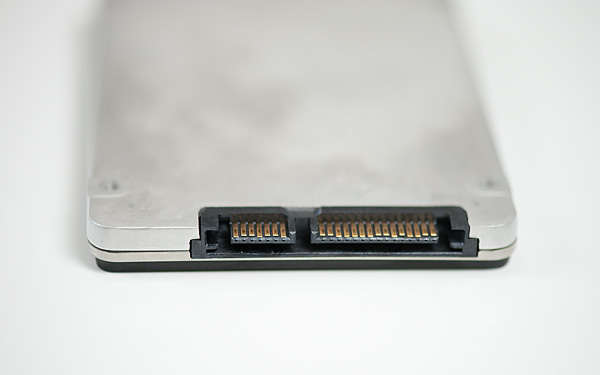Intel Z68 Chipset & Smart Response Technology (SSD Caching) Review
by Anand Lal Shimpi on May 11, 2011 2:34 AM ESTSSD Caching
We finally have a Sandy Bridge chipset that can overclock and use integrated graphics, but that's not what's most interesting about Intel's Z68 launch. This next feature is.
Originally called SSD Caching, Intel is introducing a feature called Smart Response Technology (SRT) alongside Z68. Make no mistake, this isn't a hardware feature but it's something that Intel is only enabling on Z68. All of the work is done entirely in Intel's RST 10.5 software, which will be made available for all 6-series chipsets but Smart Response Technology is artificially bound to Z68 alone (and some mobile chipsets—HM67, QM67).

It's Intel's way of giving Z68 owners some value for their money, but it's also a silly way to support your most loyal customers—the earliest adopters of Sandy Bridge platforms who bought motherboards, CPUs and systems before Z68 was made available.
What does Smart Response Technology do? It takes a page from enterprise storage architecture and lets you use a small SSD as a full read/write cache for a hard drive or RAID array.
With the Z68 SATA controllers set to RAID (SRT won't work in AHCI or IDE modes) just install Windows 7 on your hard drive like you normally would. With Intel's RST 10.5 drivers and a spare SSD installed (from any manufacturer) you can choose to use up to 64GB of the SSD as a cache for all accesses to the hard drive. Any space above 64GB is left untouched for you to use as a separate drive letter.
Intel limited the maximum cache size to 64GB as it saw little benefit in internal tests to making the cache larger than that. Admittedly after a certain size you're better off just keeping your frequently used applications on the SSD itself and manually storing everything else on a hard drive.
Unlike Seagate's Momentus XT, both reads and writes are cached with SRT enabled. Intel allows two modes of write caching: enhanced and maximized. Enhanced mode makes the SSD cache behave as a write through cache, where every write must hit both the SSD cache and hard drive before moving on. Whereas in maximized mode the SSD cache behaves more like a write back cache, where writes hit the SSD and are eventually written back to the hard drive but not immediately.
Enhanced mode is the most secure, but it limits the overall performance improvement you'll see as write performance will still be bound by the performance of your hard drive (or array). In enhanced mode, if you disconnect your SSD cache or the SSD dies, your system will continue to function normally. Note that you may still see an improvement in write performance vs. a non-cached hard drive because the SSD offloading read requests can free up your hard drive to better fulfill write requests.
Maximized mode offers the greatest performance benefit, however it also comes at the greatest risk. There's obviously the chance that you lose power before the SSD cache is able to commit writes to your hard drive. The bigger issue is that if something happens to your SSD cache, there's a chance you could lose data. To make matters worse, if your SSD cache dies and it was caching a bootable volume, your system will no longer boot. I suspect this situation is a bit overly cautious on Intel's part, but that's the functionality of the current version of Intel's 10.5 drivers.
Moving a drive with a maximized SSD cache enabled requires that you either move the SSD cache with it, or disable the SSD cache first. Again, Intel seems to be more cautious than necessary here.
The upside is of course performance as I mentioned before. Cacheable writes just have to hit the SSD before being considered serviced. Intel then conservatively writes that data back to the hard drive later on.
An Intelligent, Persistent Cache
Intel's SRT functions like an actual cache. Rather than caching individual files, Intel focuses on frequently accessed LBAs (logical block addresses). Read a block enough times or write to it enough times and those accesses will get pulled into the SSD cache until it's full. When full, the least recently used data gets evicted making room for new data.
Since SSDs use NAND flash, cache data is kept persistent between reboots and power cycles. Data won't leave the cache unless it gets forced out due to lack of space/use or you disable the cache altogether. A persistent cache is very important because it means that the performance of your system will hopefully match how you use it. If you run a handful of applications very frequently, the most frequently used areas of those applications should always be present in your SSD cache.
Intel claims it's very careful not to dirty the SSD cache. If it detects sequential accesses beyond a few MB in length, that data isn't cached. The same goes for virus scan accesses, however it's less clear what Intel uses to determine that a virus scan is running. In theory this should mean that simply copying files or scanning for viruses shouldn't kick frequently used applications and data out of cache, however that doesn't mean other things won't.













106 Comments
View All Comments
cbass64 - Wednesday, May 11, 2011 - link
Who says you can't use your old 100 or 256GB SSD as an SRT device? The article clearly states that you can use whatever size drive you want. Up to 64GB of it will be used for cache and the rest can be used for data. If you have more than 64GB of data that you need to have cached at one time then SRT isn't the solution you should be looking into.As for OS limitations...you can't seriously think Intel would wait until they had this running on every platform imaginable before they released it to the public, can you? This is the first version of the driver that supports it so of course it will have limitations. You can't expect a feature of a Windows-only driver to be supported by a non-Windows OS. I'm sure this feature will be available on Linux once Intel actually makes a Linux RST driver.
futrtrubl - Wednesday, May 11, 2011 - link
And don't forget that if you don't partition the rest of the space on the SSD it will use it for wear levelling, which will be even more important in this situation.Shadowmaster625 - Wednesday, May 11, 2011 - link
I still dont get why western digital doesnt take 4GB of SLC and solder it onto the back of their hard drive controller boards. It's not like they dont have the room. Hopefully now they will do that. 1TB +4GB SLC all for under $100 in one package, with 2 sata ports.mamisano - Wednesday, May 11, 2011 - link
Seagate has the Momentus 500gb 7200rmp drive with 4GB SLC. It's in 2.5" 'Notebook' format but obviously can be using in a PC.I am wondering why such a drive wasn't included in these tests.
jordanclock - Wednesday, May 11, 2011 - link
Because, frankly, it sucks. The caching method is terrible and barely helps more than a large DRAM cache.Conficio - Wednesday, May 11, 2011 - link
What is the OS support on those drivers (Windows?, Linux?, Mac OS X?, BSD?, Open Source?, ...)?Does the SRT drive get TRIM? Does it need it?
"With the Z68 SATA controllers set to RAID (SRT won't work in AHCI or IDE modes) just install Windows 7 on your hard drive like you normally would."???
Is there any optimization to allow the hard drive to avoid seeks? If this all happens on the driver level (as opposed to on the BIOS level) then I'd expect to gain extra efficiency from optimizing the cached LBAs so as to avoid costly seeks. In other words you don't want to look at LBAs alone but at sequences of LBAs to optimize the utility. Any mention of this?
Also one could imagine a mode where the driver does automatic defragmentation and uses the SSD as the cache to allow to do that during slow times of hard drive access. Any comment from Intel?
Lonesloane - Wednesday, May 11, 2011 - link
What happened to the prposed prices? If I remember correctly the caching drive was supposed to cost only 30-40$?Now with 110$, the customer should better buy a "real" 60GB SSD.
JNo - Thursday, May 12, 2011 - link
+1It's interesting, Anand has a generally positive review and generally positive comments. Tom's Hardware, which I generally don't respect nearly as much as Anand, reviewed SRT both a while back and covered it again recently and is far less impressed as are its readers. I have to say that I agree with Tom's on this particular issue though.
It is *not* a halfway house or a cheaper way to get most of the benefit of an SSD. For $110 extra plus the premium of a Z68 mobo you may as well get an SSD that is 40-60GB bigger than Larson Creek (or 40-60GB bigger than your main system SSD) and just store extra data on it directly and with faster access and no risk of caching errors.
For those who said SRT is a way of speeding up a cheap HTPC - it doesn't seem that way as it's not really cheap and it won't cache large, sequential media files anyway. For those who said it will speed up your game loadings, it will only do so for a few games on 2nd or 3rd run only and will evict if you use a lot of different games so you're better off having the few that count directly on the SSD anyway (using Steam Mover if necessary).
For your system drive it's too risky at this point or you need to use the Enhanced mode (less impressive) and to speed up your large data (games/movies) it's barely relevant for the aforementioned reasons. For all other scenarios you're better off with a larger SSD.
It's too little too late and too expensive. The fact that it's not worth bothering is a no brainer to me which is a shame as I was excited by the idea of it.
Boissez - Wednesday, May 11, 2011 - link
Could one kindly request for the numbers from both the 64GB C300 and 20GB sans harddisk 311 to be added. It would give a good idea of the performance hit one could expect for using these in SRT vs as a standalone boot drive.Boissez - Wednesday, May 11, 2011 - link
First sentence should be: "Could one kindly request for the numbers from both the 64GB C300 and 20GB 311 sans harddisk to be added?"... sorry